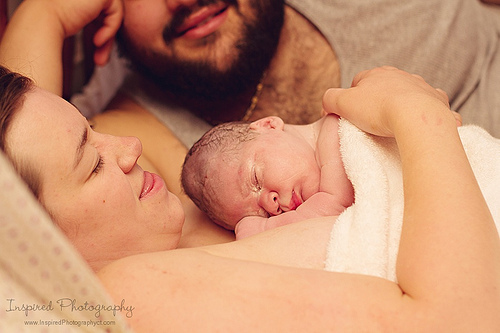Feeling the baby move even after birth can have a very simple explanation: it’s the ‘mother of the body’! Many older women talk about this condition, which can even scare some new mothers, as it is a strong belief among older populations1.

The ‘mother of the body’ would theoretically be a being that lives inside the body during pregnancy and after childbirth, starts looking for the child. Without finding her baby, she becomes restless and keeps searching. This would explain feeling those movements we often feel like trembling belly after childbirth, even for long periods.
This belief is very strong in the Amazon region, where midwives are still very prevalent. In fact, I say it is an old belief because it was known and attended to by midwives who delivered our grandmothers and great-grandmothers years ago. Where the culture of midwifery is very strong, it is an absolutely respected law. The ritual to calm the ‘mother of the body’ is indispensable after childbirth. This involves placing the placenta on the abdomen of the woman who has just given birth, and using andiroba oil to massage the lower abdomen. After performing this ritual, you should also say some words to calm the ‘mother of the body’ and restore peace to her and the woman who has just given birth.
The truth is that the ‘mother of the body’ would cause the woman to still feel movements as if she were pregnant. Women with an active ‘mother of the body’ may feel as if the movements are being made by the baby, but this happens after childbirth. The ‘mother of the body’ moves a lot, even years after delivery, which raises curiosity and concern for many women who wonder what could be happening. According to the belief, the ‘mother of the body’ can also move out of place. This would cause abdominal pain if out of place, and this displacement could be caused by exertion during labor, lifting weight after childbirth, and sudden falls during postpartum recovery. When the ‘mother of the body’ leaves its place, it causes pain. Besides feeling these pains, the woman who has just given birth may also feel discomfort and twinges.
Scientific Explanation for ‘Mother of the Body’
During pregnancy, several organs are relocated within the body2. The stomach, intestines, heart, and especially the uterus undergo huge changes in this process of creating a new life. In addition, the woman feels for several months intense movements from her developing baby. The return of the organs and the aftereffects that pregnancy brings after childbirth would be a good explanation for the involuntary movements that women experience after giving birth. Although normal, it causes strangeness and discomfort. Sometimes it can also cause malaise, due to the intense activity of the internal organs moving back. Imagine that it took months for them to move, and all very slowly. In fact, the body gradually returns to normal after childbirth, and after 45 days the woman comes out of the postpartum period and her body returns to what it was before.
And what about when the movements are felt even some time later, for example, a year after childbirth? This could be explained by the activity of the fallopian tubes and also by the movement of the uterus within the abdominal cavity3. Now, after pregnancy, it is larger and may also have more space in the abdomen.
The fact is that ‘mother of the body’ is a very strong belief, extremely respected by elders and still carried on as tradition in some cultures. I don’t think it is just a belief, it’s a way for people who deal with ‘mother of the body’ daily to explain what happens in the body after childbirth. When in doubt, it doesn’t hurt to try to calm the ‘mother of the body’, but from a scientific and contemporary point of view, this would be easily explained when taking into account how much the body changes during pregnancy. As my mother says: “I don’t believe in witches, but that they exist, oh they do!”
See also: Postpartum Menstruation – When Does It Return to Normal and Risks of Getting Pregnant
Photo: Inspired Photography CT











